Date : July 1 - 2, 2021
Sendai Coastal Area Press Tour
post date : 2021.06.02
Sendai Coastal Area Press Tour
Theme: Disaster Prevention Tourism Initiatives Creating a Resilient and Vibrant City Through Reconstruction, Ten Years After the Great East Japan Earthquake
The March 11, 2011 Tohoku earthquake and ensuing tsunami caused significant damage and a major loss of life, particularly along the coast of the Tohoku region. In the Sendai coastal area of Miyagi Prefecture, consisting of five cities and five towns (including Sendai and Natori), there were over 3,000 people dead or missing, and over 160,000 homes fully or partially destroyed[1].
Ten years after the disaster, reconstruction of hard infrastructure has been progressing in areas hit by the tsunami, including land development, building homes, and repairing roads along the coast. However, once residences have been rebuilt through efforts such as group relocation for disaster resilience and reconstruction public housing, many issues remain for soft infrastructure such as preventing isolation in new environments, building communities, and mental care for those affected by the disaster.
This tour will visit the Sendai coastal area to cover the state of reconstruction ten years after the disaster and current pressing issues, as well as disaster prevention tourism initiatives disseminating the lessons of the disaster along with the beauty of the region, amid concerns that the memories of the disaster will be lost.
[Tour Details]
1. Interview with Sendai Mayor KORI Kazuko
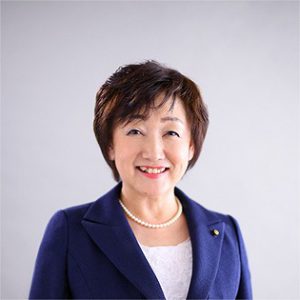 Sendai is a central city for the economy and administration of the Tohoku region, and the Great East Japan Earthquake led to 904 deaths and 27 missing people. Approximately 140,000 homes were at least partially destroyed, and the estimated cost of the damage of the disaster in the city was 1.3043 trillion yen.
Sendai is a central city for the economy and administration of the Tohoku region, and the Great East Japan Earthquake led to 904 deaths and 27 missing people. Approximately 140,000 homes were at least partially destroyed, and the estimated cost of the damage of the disaster in the city was 1.3043 trillion yen.
With the goal of leading Tohoku’s reconstruction as a whole by rapidly carrying out its own reconstruction, Sendai completed its Earthquake Disaster Reconstruction Plan in March 2016, the shortest period in disaster-affected areas at five years, and has continued reconstruction from a long-term perspective since then. Currently, based on the lessons of the Great East Japan Earthquake, Sendai is working to create a “disaster-resilient and environmentally-friendly city” and promoting disaster prevention tourism, aiming to realize a “resilient city” preparing for future disasters and the risks of climate change. Known as the “City of Trees” for its verdant nature and pleasant environment, Sendai is focusing on increasing the resilience of its infrastructure and energy supply, training people who will support disaster-prevention efforts in the community, and spreading the message of the lessons learned from the disaster. 【Photo provided by Sendai City】
◆Mayor KORI Kazuko will discuss the current state of reconstruction in Sendai and its efforts to become a disaster-resilient and environmentally-friendly city based on the lessons of the disaster. Ms. KORI became mayor in August 2017, after the retirement of former Mayor OKUYAMA Emiko, who led the reconstruction efforts since the disaster. In 2012, Ms. Kori worked as the parliamentary secretary for reconstruction.
2. Sendai 3/11 Memorial Community Center
Located at the entrance to the eastern coastal area of Sendai, which suffered severe damage from the tsunami, the Sendai 3/11 Memorial Community Center is a place to learn about the Great East Japan Earthquake, gain wisdom and lessons through communication via the medium of memories and experiences, and pass them on to the future and the world.
The community space on the first floor has 3D maps, slides, and books providing information on the eastern coastal area of Sendai, and the exhibition room on the second floor has a permanent exhibition about the damage from the disaster, along with reconstruction efforts, and special exhibitions portraying the disaster from a variety of perspectives, such as the lives and memories of people along the eastern coastal area. The facility also includes a workshop where the disaster can be discussed, a field tour introducing nearby spots, and various other events, many of which are participatory.
◆The tour will hear about Sendai’s road to recovery from a Sendai City official and community center staff.


【Photo provided by the Sendai 3/11 Memorial Community Center】
3. Disaster Prevention Tourism (Bosai Tourism)
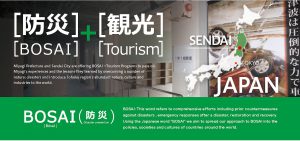 There are many disaster memorial sites and exhibits in the areas affected by the Great East Japan Earthquake, showing what the disaster was like and allowing visitors to learn from the disaster. There are also many kataribe (storytellers) who describe what the disaster was like. The Tohoku University International Research Institute of Disaster Science is promoting disaster-prevention tourism by creating a system to visit these different sites as valuable learning opportunities on disaster prevention, and combining this with the plentiful natural, cultural, and industrial tourism resources in Tohoku.
There are many disaster memorial sites and exhibits in the areas affected by the Great East Japan Earthquake, showing what the disaster was like and allowing visitors to learn from the disaster. There are also many kataribe (storytellers) who describe what the disaster was like. The Tohoku University International Research Institute of Disaster Science is promoting disaster-prevention tourism by creating a system to visit these different sites as valuable learning opportunities on disaster prevention, and combining this with the plentiful natural, cultural, and industrial tourism resources in Tohoku.
This combination of tourism and learning about disaster-prevention unique to Tohoku can bring in tourists and have them learn more about disasters, while also helping with the recovery of the tourism industry, an important factor in the reconstruction of Tohoku. In collaboration with Miyagi Prefecture, Sendai City has opened the BOSAI + Tourism website to encourage inbound disaster-prevention tourism, with support from the aforementioned institute. The website has a wide variety of content to learn about disaster prevention and a 360° virtual view of what it was like at the time of disaster, as well as local tourism information. 【Photo provided by Sendai City】
◆The tour will hear from a Sendai City official about the goals of disaster-prevention tourism passing on the experiences and lessons of the disaster in the Tohoku area to other generations and regions.
4. Arahama District, Wakabayashi, Sendai
The Arahama district located along the Pacific coast in Sendai’s Wakabayashi ward was home to around 800 households and 2,200 people before the earthquake, but the entire town was swallowed by the tsunami and over 190 lives were lost. After the disaster, nearly the entire district was designated as a “disaster risk area” in which people may not live, and the residents relocated as a group further inland. However, although the scenery remains bleak to this day, with a large tourist orchard having opened in March this year efforts by Sendai City to make use of the land which it bought from the people who carried out group relocation are picking up steam.
Arahama Elementary School is located approximately 700 meters inland from the coast, and had 91 students before the disaster. Waters reached the second floor of the school building during the tsunami, but the 320 students, teachers, and local residents who had evacuated to the school building were safely rescued by the next day. To pass on the lessons of the tsunami and limit the number of deaths from future tsunami, Sendai City established Arahama Elementary School as a disaster memorial, and opened it to the public starting in April 2017. Inside the building, the damaged classrooms, pictures from immediately after the disaster, and videos looking back on the disaster communicate the threat posed by tsunami.[2]
◆After visiting a cenotaph near the coast and a disaster memorial leaving the foundations of destroyed houses as they are, the tour will go to Arahama Elementary School. The tour will hear from a former resident of Arahama district, who works at the disaster memorial to tell visitors about the dangers of tsunami, the tsunami that struck the district, the reconstruction efforts, and how to pass on lessons from disasters.
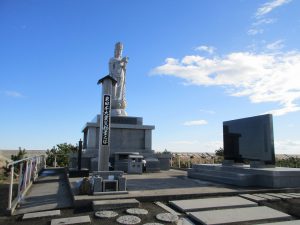
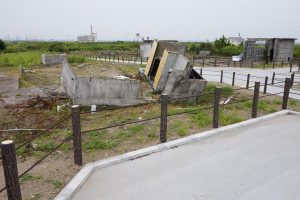
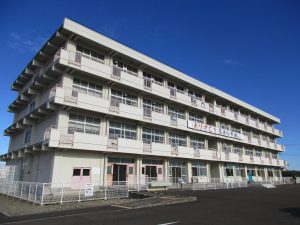
【Photo provided by Sendai City】
5. Layered Tsunami Defense and Evacuation Sites (Sendai)
Since the disaster, Sendai City has worked to rebuild the damaged eastern area and build a more resilient city, combining a layered defense with multiple facilities to stop tsunami, evacuation sites to escape tsunami, and relocating residents to ensure people’s safety even against the kind of tsunami that only happens once every few hundred years[3]. In 2019, construction was completed on a raised 10.2-kilometer road running north to south along the Sendai coast with an earthen embankment approximately six meters tall to enable it to function as a seawall. In addition to coastal seawalls and coastal forests, it is a key feature of the layered defense strategy intended to greatly decrease the damage from tsunami.
The Arahama District Evacuation Hill, a tsunami evacuation site built across from the old Arahama Elementary School, is ten meters above sea level with an area of approximately 5700 square meters on its top. Able to hold around 5,300 people if a tsunami should come, it is the largest of the five “evacuation hills” the city built along the coast. Built in preparation for the reopening of seawater baths and the opening of the new tourist orchard, the hope is that the evacuation hills will make people feel safer about visiting Arahama district and attract more people to bring a renewed vibrancy to the area.
◆Along with an explanation of layered tsunami defense from a city official, the tour will visit sites where measures have been taken to limit the damage from tsunami: the Arahama District Evacuation Hill, Sasayashiki Tsunami Evacuation Building, and Sendai Eastern Road Evacuation Staircase (the building and staircase will just be seen from the vehicle.)
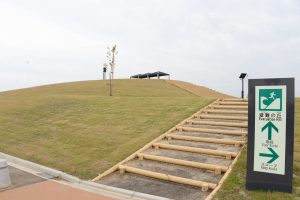
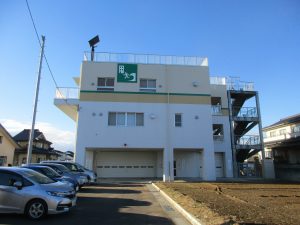
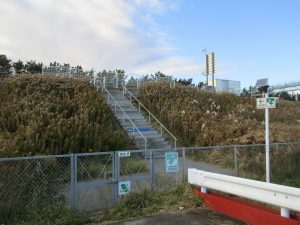
【Photo provided by Sendai City】
6. Araihigashi Reconstruction Public Housing (Sendai)
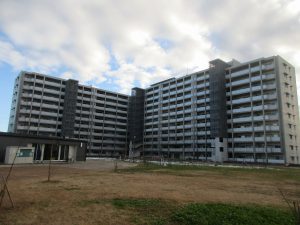 At its peak in March 2012, there were approximately 12,000 households living in emergency temporary housing within Sendai, but as inland residential areas in hilly areas were restored and reconstruction public housing built (3,206 residences), people steadily moved out of the temporary housing. By March 2017, they had succeeded in a recovery of the foundation of daily life, restoring homes to every household excluding those from outside Sendai. After reconstructing their homes, Sendai City has continued to work in cooperation with ward offices, social welfare councils and others on supporting the physical and mental health of residents in reconstruction public housing or after group relocation, with efforts to prevent isolation and build communities.
At its peak in March 2012, there were approximately 12,000 households living in emergency temporary housing within Sendai, but as inland residential areas in hilly areas were restored and reconstruction public housing built (3,206 residences), people steadily moved out of the temporary housing. By March 2017, they had succeeded in a recovery of the foundation of daily life, restoring homes to every household excluding those from outside Sendai. After reconstructing their homes, Sendai City has continued to work in cooperation with ward offices, social welfare councils and others on supporting the physical and mental health of residents in reconstruction public housing or after group relocation, with efforts to prevent isolation and build communities.
Many former residents of coastal districts such as Arahama and Gamo districts now live at Araihigashi Reconstruction Public Housing, a large complex with a total of 298 units, after having lived in evacuation sties and emergency temporary housing. The Araihigashi Reconstruction Public Housing residents’ association and the social worker in charge of checking in on the senior citizens in the complex and surrounding area have seen for themselves the issues involved in rebuilding lives, including residents having lost local community connections due to the tsunami, the difficulty of building a new community in reconstruction public housing where people who do not know each other all moved in within a short time frame, the ageing of the residents, and the lack of people to carry out resident association activities.
◆The tour will hear from a Sendai City official and Sendai social welfare council worker who has supported people affected by the disaster since it occurred about the current state of rebuilding the lives of those affected by the disaster, including former residents of Arahama district, and the issues they have seen firsthand during their efforts. The residents’ association and local social worker will also discuss the current state of residents living in reconstruction public housing and after group relocation.
7. Tagajo Industrial Complex Base for Tsunami Reconstruction: Sanmirai Tagajo Industrial Complex (Tagajo)
The city of Tagajo had an industrial area facing Sendai Bay, with electronics, metal, and food product manufacturing as its core industry, and approximately one third of the city’s area was flooded by the tsunami. In addition to the damage to homes, debris, sand, over 5,000 vehicles, and tankers all washed into the city, damaging offices and factories. Many businesses along the coast were unable to continue operating, and were forced to go out of business or downsize[4]. At the same time, it became a noticeable issue that the large amounts of emergency goods sent to Tagajo and other affected areas right after the disaster from Japan and elsewhere were left unpacked, unable to be efficiently stored or distributed to evacuation sites.
Based on those experiences, Tagajo City built an industrial complex base for tsunami reconstruction (known as Sanmirai Tagajo Industrial Complex) with functions to distribute goods in the case of a disaster and to support industrial reconstruction. The Sanmirai Tagajo Event Plaza (STEP) in the complex is normally used as an indoor futsal court and more, but in times of disaster it can be used as a headquarters to receive and organize supplies out of the weather. Its warehouse stores 72,000 meals worth of food along with blankets, cardboard beds, and other supplies. Companies in the complex have entered into an agreement with Tagajo City to distribute food to citizens and take in evacuees in the case of a major disaster, as well as provide support to businesses damaged in the case of a major tsunami so they can continue to provide their goods. So far, 12 companies have entered the complex, primarily food processors.
◆A Tagajo City employee will show the tour around STEP, explaining the new concept of an industrial complex with both disaster-resilience and industry reconstruction support functions.


8. Tsunami Reconstruction Prayer Center: Memoire de Yuriage (Natori)
The Yuriage district, located along the coast in Natori, south of Sendai, was home to approximately 5,700 people before the disaster. It was hit by tsunami up to nine meters tall in the disaster, and around 750 people lost their lives. Ten years after the disaster, construction of homes and commercial facilities is proceeding on raised ground and a new townscape is beginning to show itself. Many people visit the Yuriage Harbor Morning Market which reopened in 2013 and the commercial facility Kawamachi Terrace Yuriage which opened in 2019, and vitality is slowly returning to the town.
Opened in April 2012, tsunami reconstruction prayer center Memoire de Yuriage started as a shrine office maintaining a cenotaph built by the families of the 14 students of Yuriage Junior High School who lost their lives in the tsunami, and is a place for the people of Yuriage to come together and pass on memories of the disaster. The name Memoire de Yuriage was chosen in the hopes it could be a place for survivors of the disaster to come to terms with their feelings and memories, deal with important memories, and begin moving forward again. With mental care for those affected by the disaster being recognized as a problem, when they work as kataribe or guides and discuss the disaster it gives them the opportunity to deal with their feelings, as well as allowing visitors to Yuriage to learn about the area, and Memoire de Yuriage has become a place to learn about how people can face disaster and about the value of life.
◆The tour will hear from kataribe Ms. TANNO Yuko (representative of the Yuriage Junior High School Bereaved Families Association), who started Memoire de Yuriage, about the activities at Memoire de Yuriage as a center for mental care for people affected by the disaster.
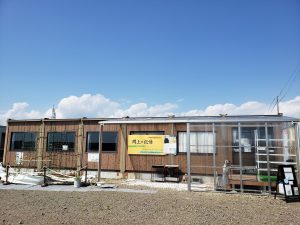
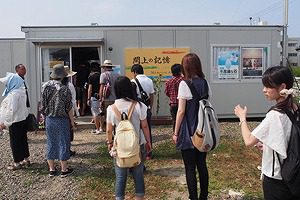
【Photo provided by Memoire de Yuriage】
9. Maruta Suisan Co., Ltd. (Natori)
 Maruta Suisan is a seafood processing company, handling fresh seafood caught in Sendai Bay, including Yuriage’s famous akagai (ark shell), more of which is caught there than anywhere else in Japan. With salted akagai as their main product, the company was steadily growing when the tsunami completely destroyed their processing plant. Company president Mr. AIZAWA Nobuyuki, along with his son and executive director Mr. AIZAWA Futoshi, helped with boiling shirasu (baby sardines) at a seafood processing company in Shizuoka Prefecture that offered to support companies affected by the disaster. Half a year later, Mr. Nobuyuki returned to Yuriage and immediately began making products such as dried seafood again at a processing plant he borrowed from an acquaintance. In 2012, he restarted the business in earnest by processing akagai at a temporary plant he had built, and in 2016 the new plant the company now uses was made, with Mr. Futoshi returning the next year after working at a major seafood company in Tokyo to learn from them.
Maruta Suisan is a seafood processing company, handling fresh seafood caught in Sendai Bay, including Yuriage’s famous akagai (ark shell), more of which is caught there than anywhere else in Japan. With salted akagai as their main product, the company was steadily growing when the tsunami completely destroyed their processing plant. Company president Mr. AIZAWA Nobuyuki, along with his son and executive director Mr. AIZAWA Futoshi, helped with boiling shirasu (baby sardines) at a seafood processing company in Shizuoka Prefecture that offered to support companies affected by the disaster. Half a year later, Mr. Nobuyuki returned to Yuriage and immediately began making products such as dried seafood again at a processing plant he borrowed from an acquaintance. In 2012, he restarted the business in earnest by processing akagai at a temporary plant he had built, and in 2016 the new plant the company now uses was made, with Mr. Futoshi returning the next year after working at a major seafood company in Tokyo to learn from them.
At the same time, the akagai catch in Yuriage, their main product, became lower than usual, while it also became possible to catch shirasu in Yuriage, even though previously the furthest north shirasu could be caught was around Fukushima Prefecture. The Aizawas asked for advice from the processing company in Shizuoka that had helped them out, and used the shirasu to make a new product, with the Hokugen no Shirasu (“Northern Limit Shirasu”) brand based on these shirasu being the northernmost shirasu caught in Japan. Hokugen no Shirasu has become recognized as a new Yuriage specialty, brining prosperity to the region. In October 2020, Mr. Futoshi opened Café Malta, which serves dishes using Hokugen no Shirasu, and he commented, “We will make a new Yuriage together. I want to make this into a place where the people of Yuriage gather.”
◆The tour will visit Café Malta, which opened in 2020, and hear from the Aizawas about their road to reconstruction, including their fateful meeting with shirasu.

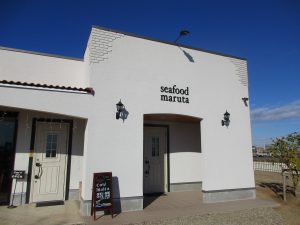
10. Yamamoto Disaster Memorial Nakahama Elementary School (Yamamoto)
 Located on the Pacific coast in southeastern Miyagi Prefecture, the town of Yamamoto had about 40% of its area flooded during the tsunami, leading to 637 dead and 2,217 homes completely destroyed.
Located on the Pacific coast in southeastern Miyagi Prefecture, the town of Yamamoto had about 40% of its area flooded during the tsunami, leading to 637 dead and 2,217 homes completely destroyed.
Nakahama Elementary School, a two-story building approximately 400 meters from the coast, is the only disaster memorial site remaining in southern Miyagi Prefecture. At the time of the disaster, it was struck by a tsunami around ten meters tall, flooding up to the ceiling of the second floor. The principal at the time, Mr. INOUE Takeshi, decided that it would not be possible to walk to the evacuation site further inland, and so 90 students, teachers, and parents evacuated to the attic storage area under the school’s roof. After spending a night in subzero temperatures, they were all safely rescued the next day.
The school closed in March 2013, but Yamamoto Town repaired it while retaining as much of the damage from the tsunami as possible, opening it to the public in September 2020 as a disaster memorial site to pass on the lessons of the disaster so they are not forgotten and communicate the importance of preparing for disasters. Inside the building, the ceiling torn away by the tsunami, desks and chairs covered in mud, and the outfits from school plays children used to keep warm while evacuated to the attic are all preserved as they were, making this a valuable facility to communicate the threat of disaster in ways that pictures and video cannot.【Photo provided by Nakahama Elementary School】
◆Currently, there is no entry allowed due to issues caused by the earthquake in February 2021 and lightning in May, but the tour will see the school from the memorial square outside, and hear from former Principal INOUE, who passes on the lessons of the disaster at the school as a kataribe, about his experiences at the time, and his thoughts now.
11. Agricultural Production Corporation GRA Inc. (Yamamoto)
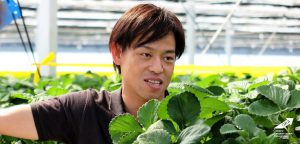 Strawberry farming has long been a key industry in Yamamoto, with approximately 130 strawberry farms in the town before the disaster, but 95% of their farmland was damaged by the tsunami. Mr. IWASA Hiroki, who had been born in Yamamoto and was running an IT company in Tokyo, returned home as a volunteer and was told by locals that they wanted him to “create jobs and economic opportunity,” so he decided to return to his hometown. With the goal of carrying out reconstruction by bringing new employment and economic opportunities to the town through a structural reform in the local specialty of strawberry farming, he established GRA in January 2012 together with Mr. HASHIMOTO Yohei, another Yamamoto local who had been working as part of the Yamamoto social welfare council at the time of the disaster, and they set a target of creating 100 companies and 10,000 employment opportunities within 10 years.
Strawberry farming has long been a key industry in Yamamoto, with approximately 130 strawberry farms in the town before the disaster, but 95% of their farmland was damaged by the tsunami. Mr. IWASA Hiroki, who had been born in Yamamoto and was running an IT company in Tokyo, returned home as a volunteer and was told by locals that they wanted him to “create jobs and economic opportunity,” so he decided to return to his hometown. With the goal of carrying out reconstruction by bringing new employment and economic opportunities to the town through a structural reform in the local specialty of strawberry farming, he established GRA in January 2012 together with Mr. HASHIMOTO Yohei, another Yamamoto local who had been working as part of the Yamamoto social welfare council at the time of the disaster, and they set a target of creating 100 companies and 10,000 employment opportunities within 10 years.
By implementing IT production management into strawberry farming, GRA made it possible to efficiently provide a steady supply of high-quality strawberries without having to rely on the instincts of a veteran farmer. The company succeeded in improving quality and establishing a brand with Migaki-Ichigo strawberries, with the highest-quality ones sold at department stores in the Tokyo area for 1,000 yen each, and opened Ichibiko, a chain of cafés which specialize in strawberry sweets and use Migaki-Ichigo strawberries, with seven locations in Tokyo and two in Miyagi. The company’s tourist farm Ichigo World is visited by around 50,000 people per year, over four times the population of Yamamoto (12,000), and is having an economic impact.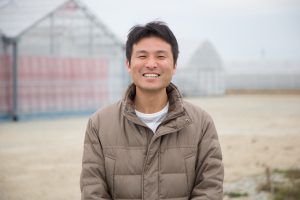 GRA is also putting effort into a project to support people with no agricultural experience going independent in a short time, with many people coming from outside the prefecture to learn about managing a strawberry farm, and some who finished that program have moved to Yamamoto and started strawberry farms there. 【Photo provided by GRA】
GRA is also putting effort into a project to support people with no agricultural experience going independent in a short time, with many people coming from outside the prefecture to learn about managing a strawberry farm, and some who finished that program have moved to Yamamoto and started strawberry farms there. 【Photo provided by GRA】
◆The tour will hear from Mr. HASHIMOTO, GRA's vice-president and head of its cultivation department. He met Mr. IWASA through volunteering in disaster recovery efforts, and the two founded GRA in order to revitalize strawberry farming in Yamamoto. He will discuss the history of GRA since the disaster and their future plans.

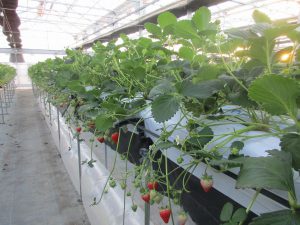
[Tour Itinerary]
1. Schedule
*The schedule is not yet finalized, and may change without notice.
<Thursday, July 1>
07:08-8:40 Tokyo Station to Sendai Station (Hayabusa 3)
09:20-10:00 Sendai City briefing
10:20-11:10 Arahama district (Arahama Cenotaph, house foundation disaster memorial, Arahama Elementary School), walking *Bus in case of rain
11:15-12:15 Arahama Elementary School
12:20-12:50 Arahama District Evacuation Hill
13:10-13:50 Lunch at Memorial Community Center
14:10-14:45 Layered tsunami defense and evacuation sites (through car window)
15:00-16:30 Araihigashi Reconstruction Public Housing
17:00-18:30 Sanmirai Tagajo Industrial Complex
19:15 Hotel (Sendai)
<Friday, July 2>
7:40 Leave hotel
8:30-10:00 Tsunami Reconstruction Prayer Center: Memoire de Yuriage
10:10-11:40 Maruta Suisan Co., Ltd.
11:50-12:20 Lunch@the commercial facility Kawamachi Terrace Yuriage
13:10-14:40 Yamamoto disaster memorial Nakahama Elementary School (exterior only)
14:55-16:10 Agricultural Production Corporation GRA Inc.
17:30-18:30 Interview with Sendai mayor
19:31-21:04 Sendai Station to Tokyo Station (Hayabusa 42)
2. Qualification: Bearer of Gaimusho Press Registration Card
3. Cost: 13,000 yen per person, including transportation, accommodation (breakfast included) and lunch on the 1st day.
(You will have lunch on your own on the 2nd day at Kawamachi Terrace Yuriage, and pay for it yourself.)
*The following cancellation fees will apply:
-Cancellation before 3 p.m., Wednesday, June 30: 6,500yen
-Cancellation after 3 p.m., Wednesday, June 30: 13,000 yen (full amount)
4. Participants: Limited to 8 applicants.
(Only one reporter or one photographer from each company, but two participants from each TV team will be acceptable.)
*If the number of applicants exceeds 8, an upper limit may be set on the number of participants from each country/region.
5. FPCJ Contact: ISHIDA Megumi, YAMADA Mihoko
(Tel: 03-3501-3405、E-mail: ma@fpcjpn.or.jp)
6. Measures for COVID-19
Please follow the directions of the staff, such as taking temperatures before the tour, wearing masks and face shields during the tour, washing hands, and using disinfectant. In the following cases, you will not be able to join the tour:
(1) If you have a fever of 37.5°C or over when your temperature is taken before the tour starts
(2) If, in the two weeks before the day of the tour, you had a fever, cough, sore throat or other cold symptoms, difficulties tasting or smelling, fatigue, shortness of breath, or other symptoms
(3) If, in the two weeks before the day of the tour, you came into close contact with someone who tested positive for COVID-19
(4) If a family member living with you or other close acquaintance is suspected to have COVID-19
(5) If, in the two weeks before the day of the tour, you have travelled to a country under travel restrictions or requiring an observation period after entering Japan, or have come into close contact with someone who has
7. Remarks:
(1) This tour is organized by Sendai City, and planned and operated by Kinki Nippon Tourist Tohoku Co., Ltd. and the FPCJ
(2) The schedule is subject to change without notice.
(3) This tour will require participants to bear part of the cost, but is not a profit-making venture.
(4) Sendai City, Kinki Nippon Tourist Tohoku Co., Ltd. and the FPCJ will not be liable for any inconvenience, trouble or accidents that might occur during the tour.
(5) There may be some restrictions on photographing and filming at the tour sites. Please follow the instructions of the staff in charge.



